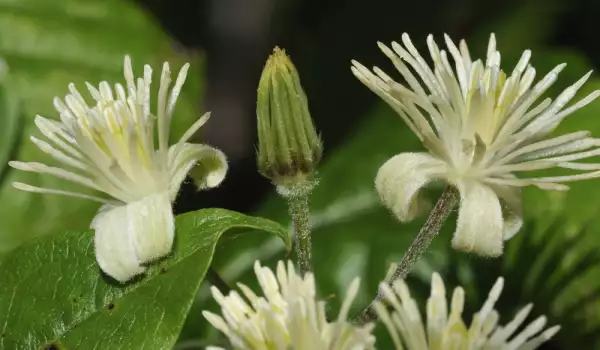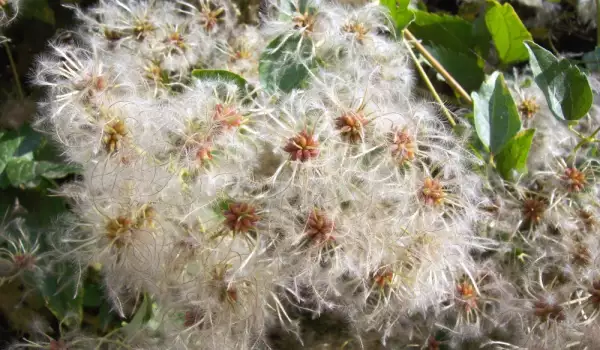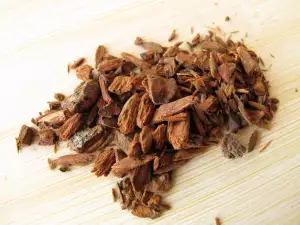Clematis / Clematis vitalba L. / is a perennial woody, branched and climbing plant of the Ranunculaceae family. It is spread throughout - from the coasts to 6560 ft (2000 meters) above sea level in the mountains.
It grows among bushes, in flowering places in the forest, all over fences and walls. The best places for it are riparian scrubs and woodlands where it often climbs the tree tops and covers their crowns. It is widespread in the Caucasus, Europe and Southwest Asia.
The stem of the clematis grows to lengths of up to 98.5 ft (30 meters). It flourishes out from a well-developed rhizome and lives up to 24 years. Its leaves are pinnate, along opposite sides of the stem and with long petioles.
Clematis begins blooming at the end of May and lasts until late August or early September. The flowers have long petioles, meeting in complex brushy clusters. They are white and have a weak aroma. There are four leaflets around the flowers, with many stamens.
Soon after the flowers of clematis start to fade, their place is taken by fluffy, silver-grey fruits that are the size of a tennis ball. Each fruit contains numerous elongated and slightly flattened reddish-brown berries.
Although ordinary clematis often appears as a bothersome weed, it is a useful medicinal and decorative plant. It is very beautiful when the large pinnate leaves appear, but becomes even more glorious with the blooming of its white petals.
Therefore, in many European countries, clematis is grown as a decorative plant in parks and gardens, mostly for landscaping in gazebos and pavilions.
Composition of clematis
Clematis contains: protoanemonin which during drying becomes anemonin, vitamin C and provitamin A, essential oil, saponin leotin, trimethylamine, glycosides, waxy substances, miricil and ceril alcohol. It also harbors valuable alkaloids - clematitol, anemones, lenontil.

Collection and storage of clematis
The above ground portions of the plant are collected For therapeutic purposes. Its collection should be done during flowering - May and June. The roots are also used for medical purposes, but can be harvested year-round.
Clematis is dried in the shade with maximum humidity being about 12% for the dried herb. The shelf life of chopped stems is 2 years and when whole - 3 years. Store dried clematis in cool and dry places.
Benefits of clematis
Clematis has a very good diaphoretic, diuretic, fungicidal and bactericidal action. It is used for headaches, swelling, against stomach ulcers, boils, joint pain and exostosis. Clematis helps with inflammation of the eyes, some venereal diseases, fever, and varicose veins.

Traditional medicine with clematis
In folk medicine, clematis was used for stomach ulcers, fever, ulcers of varicose veins. Externally, it is used for baths against scabies and is applied topically to boils. The same effect comes from the root of the herb.
The sub-cortical tissue of the stem, freshly crushed and mixed with olive oil, is applied in the form of stems for treating exostosis, joint pains and rheumatism. Imposition must not be longer than 6 hours, since there is a danger of burns.
For internal use, 1 teaspoon of clematis is placed in 17 fl oz (500 ml) of water and boiled for 5 minutes. Drink one cup before meals, three times daily.
To make the oil extract of clematis, pour 10 parts of olive oil over 1 part dry leaves and let it stand for about 10 days. Use for topical administration.
Dangers of clematis
Clematis should be taken according to medical indication, in the correct doses, to avoid possible side effects. In case of overdose, symptoms of poisoning affect the nervous system, cause loss of pain sensitivity and decreased body temperature. When picking stems and leaves, they can cause skin irritation.







